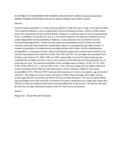ACCEPTABILITY OF COMPLEMENTARY PORRIDGE ENRICHED WITH CRICKETS (Acheta domesticus) AMONG WOMEN OF REPRODUCTIVE AGE IN ALEGO-USONGA SUB-COUNTY, KENYA
Abstract
Protein-energy malnutrition is common among children of under five years of age in
sub-Saharan Africa. This is mainly attributed to poor complementary foods and feeding
practices, which are often cereal-based and characterized by low nutrient density.
Soybean is commonly used to enrich complementary foods, nonetheless, its prospects
for use as a rich source of protein and minerals is limited by its low protein digestibility
and bioavailability of minerals, costly production and contribution towards
environmental degradation. Crickets provide cheap and sustainable source of protein
and other nutrients, and holds the potential for substituting soybean in complementary
porridge formula. To evaluate acceptability of complementary porridge enriched with
crickets, Famila complementary porridge flour, a composite of maize, wheat and
defatted soybean was enriched with cricket flour by substituting soybean with cricket
flour at 0%, 25%, 50% and 75%. Four porridges were prepared from the flours and
coded as CP, CPB1, CPB2 and CPB3, respectively. A total of 40 semi-trained women
evaluated the porridges on colour, taste, aroma, texture, mouth-feel and overall
acceptability on a 9 -point hedonic scale. The overall acceptability of the porridges
were as follows; CP (8.5 ± 0.72), CPB1 (7.08 ± 0.94), CPB2 (5.75 ± 1.53) and CPB3
(3.60 ± 1.95). Control porridge (CP) was highly rated in all sensory attributes while
CPB3 was rated the lowest in all the attributes. Unlike CP, the overall acceptability of
CP1, CPB2 and CPB 3 improved with experience in insect consumption, age and level
of education. The ratings for colour, aroma and taste of cricket-based porridges were
higher among women aged 30 years and above, and those with post-primary education.
The most accepted cricket-based porridges were CPB1 and CPB2. Enrichment of
Famila complementary porridge with cricket flour affected its sensory attributes which
were perceived differently by the women. This informs the need for both low and high
substitution levels to cater for their diverse preferences.
URI
https://doi.org/10.18697/ajfand.100.20330https://ajfand.net/Volume21/No5/Aboge20330.pdf
http://ir-library.mmust.ac.ke:8080/xmlui/handle/123456789/2003
Collections
- Journal Articles [411]

